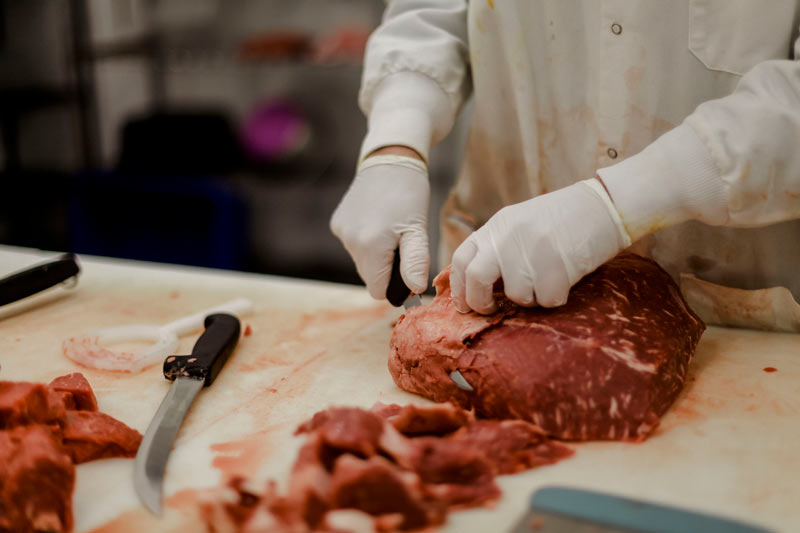Why Citizens Love Bagley Farms Meat Market Edwardsville IL for Their Meat Shopping
Why Citizens Love Bagley Farms Meat Market Edwardsville IL for Their Meat Shopping
Blog Article
Uncover the Art of the Butcher's Cut in a Modern Meat Market
In the ever-evolving landscape of modern meat markets, the butcher's cut has actually transcended its traditional origins, combining olden workmanship with modern techniques. Today's butchers are not merely cpus of meat; they are experienced craftsmens that highlight sustainability and moral sourcing. Their knowledge in picking and preparing cuts tailored to certain cooking needs offers an unparalleled dining experience. What truly establishes the modern butcher apart is their capacity to build a much deeper link in between customers and the origins of their meat. Just how do these masters equilibrium tradition with development, and what ramifications does this have for the future of meat consumption?
Advancement of Butchery Techniques
The development of butchery strategies mirrors an abundant tapestry of advancement and adaptation driven by innovations in innovation, modifications in consumer need, and a deeper understanding of meat science. Historically, butchery was a craft passed down through generations, with techniques sharpened over centuries to take full advantage of yield and flavor. Nonetheless, the commercial change introduced automation, transforming conventional methods and enabling massive handling.
The mid-20th century saw butchery strategies even more fine-tuned by clinical understandings right into muscular tissue biology and meat aging, enhancing both tenderness and taste. Innovations like vacuum product packaging and refrigeration prolonged product shelf-life, allowing butchers to diversify offerings and improve quality control. This duration likewise marked the surge of specialized tools, such as band saws and meat slicers, which raised accuracy and efficiency in meat processing.

The 21st century has actually introduced digital technology right into the butchery world. Electronic systems now help in monitoring animal provenance and optimizing cuts to fulfill particular client preferences. Additionally, a renewal in artisanal butchery has actually emerged, blending standard abilities with contemporary understanding to satisfy consumers seeking moral and sustainable meat alternatives. This evolution emphasizes a vibrant interplay between custom and technology, meeting contemporary needs while protecting the craft's heritage.
Recognizing Meat Cuts
Comprehending the ins and outs of meat cuts is essential for both butchers and customers seeking quality and value. For butchers, accurate cuts reflect skill and regard for the craft, guaranteeing minimal waste and ideal yield.

Comprehending muscular tissue composition is vital; muscle mass made use of much more often by the animal tend to be harder and are best suited for slow food preparation techniques, while less-used muscles, like those located in the loin, are extra tender and perfect for cooking or roasting. Familiarity with these distinctions empowers consumers to make enlightened choices, improving their culinary undertakings.
Choosing Quality Meat
Choosing the right meat involves even more than just selecting a visually appealing piece from the display. his explanation bagley farms meat market edwardsville il. The art of selecting quality meat calls for a discerning eye and knowledge of certain characteristics that symbolize freshness and quality. Firstly, pay interest to the color; beef must have an intense, cherry-red tone, while lamb should display a soft pink tone, and pork a light pink. This indicates the meat is fresh and hasn't been subjected to oxygen for also long.
Second of all, consider the marbling, which describes the white streaks of fat within the muscular tissue. Correct marbling is a key sign of tenderness and taste, as it melts throughout food preparation, boosting the meat's juiciness. Remember, greater marbling usually correlates with superior top quality cuts, such as USDA Prime.
Structure is another critical element; meat must feel solid to the touch, not slimed or excessively soft. Additionally, be conscious of the aroma. Fresh meat should have a clean, neutral odor, without any kind of sour or off-putting odors.
Coupling Cuts With Food Preparation Approaches

Conversely, harder cuts like brisket and chuck roast are abundant in collagen, which damages down right into jelly when cooked slowly. These cuts are suitable for braising or slow roasting, allowing the meat to tenderize in time and establish deep, complex flavors. Cuts such as short ribs and pork shoulder get on well with slow-cooking techniques, where prolonged cooking times transform their robust structures right into succulent recipes.
Lamb shanks and oxtail, which call for long term cooking to soften, are best navigate to this website prospects for cooking or sluggish simmering. These methods coax out abundant, passionate tastes while maintaining moisture. By comprehending the distinct features of each cut, cooks and home chefs alike can boost their cooking creations, guaranteeing each dish is both pleasing and memorable.
The Butcher's Duty Today
Navigating the advancing landscape of the contemporary meat market, the butcher's role today expands beyond mere preparation of cuts. Contemporary butchers are cooking craftsmens, teachers, and resource advocates for sustainable practices.
In enhancement to crafting exact cuts, butchers now engage straight with customers, providing cooking recommendations and customizing options to fit private requirements and preferences. Their experience in meat aging, marbling, and taste profiles equips customers to make informed choices, improving their culinary experiences. This personalized service exhibits the butcher's progressing function as a relied on expert in the cooking area.
Additionally, butchers are pivotal in minimizing waste, utilizing whole animals to develop varied products such as sausages and stocks. This detailed method not only appreciates the pet however likewise straightens with modern sustainability objectives. By doing this, the modern butcher personifies both tradition and development, adapting to an ever-changing market while preserving the virtuosity and stability of their craft.
Verdict
Mastery in understanding diverse meat cuts and high quality signs empowers butchers to supply enlightened suggestions, aligning certain cuts with ideal food preparation techniques. By honoring historical techniques while welcoming contemporary demands, the butcher's role continues to be crucial in today's sophisticated meat market.
Report this page